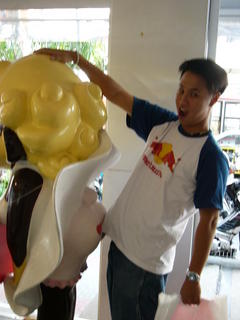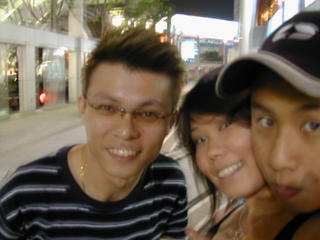itching..
my debit card has been eaten up but the atm machine! i have no access to all my funds! lucky won some money from mahjong session on friday.. seriously.. it was the most i have won so far.. couldnt believe that all my cards are so nice and good... is it luck? or is it skill?? i guess i can say its mostly luck.. but then again.. lucky i got skills also.. all my cards were scraps to the max and no one is feeding me.. a change of tactics did the trick.. need to get my debit card back!!!
here's something interesting..
Mah Jong (mah jongg) is a traditional Chinese tile game with manyvariations. An ancient game widely played in China and Japan, "American" mahjong came to the U.S. in the 1920s. "Mahj" became very popular, particularly in Jewish-American women's circles. The "American" version of the game uses of special cards outlining combinations of hands that players collect. Also widely played in the U.S. is the Chinese version of the game. This traditional version is simpler, and yet many believe it to be more enjoyable. These notes present a traditional Chinese variation of mah jong.
In Chinatowns throughout the country, mah jong is played regularly and often associated with gambling and serious competition. For those who simply love games, mah jong can be played with the same enthusiasm and competitive spirit for "bones" or "chips" signifying points. It is with the "friendly play" viewpoint that these notes are offered. One warning, however: you may become hooked! You may begin to want to play all the time, and will spend your free time searching for different types of sets to collect. Beware!
The game resembles playing card games like rummy. Many assert that playing cards are derived from the ancient tile game of mah jong. In the absence of the beautiful sets, often made of bone and bamboo,the game may also be played with special cards.
The literal translation of "Mah Jong" is "flax/hemp" "sparrow clattering." Those who play the game love the sound of the tiles as they are mixed together prior to the start of each hand. Listening carefully, players hear the sound of the flax blowing in the wind and the sparrows clattering.
These notes should help the novice learn to play the game of mah jong. Ideally, four interested players should study the notes together, and find their way through a few hands. Before long, you will be playing with certainty and confidence, and enjoying this game of skill and luck.
A complete set contains 144 tiles. The tiles fall into four categories: suits, honor tiles, flowers and seasons.
There are three suits: the dots (also called circles or balls), the bamboos (also called bams or sticks), and the characters (also called characks, cracks, or wan). The suit tiles are numbered 1 through 9, and in any given suit, there are four of each number. Suit tiles may be either simple or terminal. Terminal tiles, 1s and 9s, are more valuable in winning, than simples, 2s through 8s. Most American sets have English numbers on each tile in addition to the correct number of symbols (dots or bamboos). In the character suit, instead of the corresponding number of symbols on the tile, the Chinese numeral character appears above the character signifying 10,000. A "one crack" then would have the Chinese character for the number one, above the Chinese character for the number 10,000 -- signifying "one ten-thousand" or one "wan." If a set does not have the English numbers on the tiles, the Chinese characters for 1 through 9 must be memorized. A true Chinese set will not have any other numbers appearing on the tiles. The 1 bamboo is usually a bird.
Character Tiles
There are two types of honor tiles: the winds (East, South, West, and North) and the dragons (Red, Green, and White). Just as there are four of each suit number, there are four of each wind and four of each dragon. As with the character tiles, the wind tiles usually have the corresponding English letter on the tile. If the set does not have these letters, players must memorize the Chinese symbol for each of the directions.
The dragons appear on some Americanized sets as dragons in the colors in red, green and white. On more traditional sets, the red has the Chinese character (in red) for Cheung -- meaning center of the four directions. Some sets will have a "C" on the red dragon character tile. Similarly, in traditional sets, the green dragon is not really a dragon, but a green imprinted Chinese character, Fa (or Fa Choy), meaning "commence" or "begin good luck." The green dragon will often have an "F" appearing on the tile.
The white dragon (also known as white board, soap, bak board, or pak board) may have a rectangle on the tile. In some sets, a "P" or "B" appears as well.
The flower and season tiles differ in nature from the suit and honor tiles. There are only 4 flowers (1, 2, 3, and 4) and only 4 season tiles (1, 2, 3, and 4). Some versions of the game call for exclusion of the flower and season tiles. In most Chinese-American circles, they are used however. Their use is somewhat like that of the joker in card games. When drawn, they are declared and a substitute tile is drawn. They are not collected for scoring, but as will be described later, the flower(s) or season(s) corresponding with the winning player's wind may double the winning score one or more times.

































